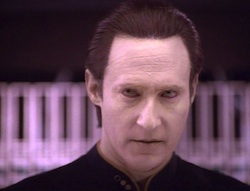Holiday rewatch schedule: We’ve got the first part of “Descent” today, and Friday the 21st will be the sixth-season overview. We’ll be skipping both Christmas Day and New Year’s Day, so “Descent, Part II” will be on Friday the 28th and then “Liaisons” will be on Friday the 4th of January in 2013. After that the Tuesday/Friday schedule will resume as usual.
“Descent” (Part One)
Written by Jeri Taylor and Ronald D. Moore
Directed by Alexander Singer
Season 6, Episode 26
Production episode 40276-252
Original air date: June 21, 1993
Stardate: 46982.1
Captain’s Log: Data has created a poker game on the holodeck, where he is playing Sir Isaac Newton, Dr. Albert Einstein, and Dr. Stephen Hawking. After Hawking wins with four sevens, Riker calls red alert, and Data ends the program.
The Enterprise has received a distress call from Ohniaka III, an outpost with no strategic value whatsoever. There’s a ship in orbit matching no known configuration, but it’s taking no action and answering no hails—and there’s interference preventing Data from reading life on the planet.
Riker, Data, Worf, and a security guard named Corelki beam down to find a ton of dead bodies, brutally murdered. They split up (they can do more damage that way): Riker and Data in one direction, Worf and Corelki in the other. Riker and Data find a room with a door that’s jammed. Data clears it, and it opens to reveal a Borg.
And then all hell breaks loose. One Borg fires on Riker, and then several other Borg show up to attack all four members of the away team—at the same time the ship in orbit fires on the Enterprise.
Something’s different, though: the Borg are less meticulous, more emotional. When Riker kills one with a phaser, another gets angry, saying the away team will suffer for his death, and referring to itself with the first-person pronoun “I.” Then one physically attacks Data, and the android gets angry, yells at the Borg to stop it, and throws him violently into the bulkhead.
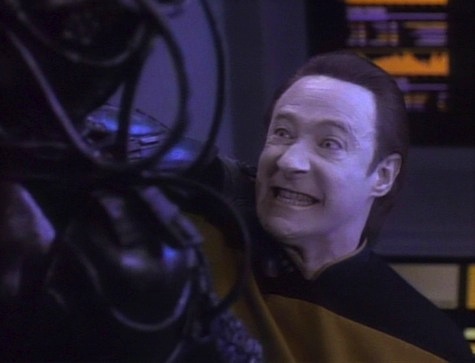
After one Borg identifies Data, the Borg suddenly all beam away, the ship breaks orbit, and then disappears into some kind of subspace field just as the Enterprise fires on it. La Forge has no idea what the Borg ship did.
Data asks to be taken off duty. Picard meets with Riker, Worf, Crusher, and Troi to discuss these new, unimproved Borg. Crusher posits that this may be a byproduct of the individuality of Hugh that they placed in the collective in “I, Borg.” Either way, these Borg were vicious, nasty, and showed no interest in assimilating, just killing.
La Forge examines Data, and Data examines himself, and they find nothing. Data also can only really assume that he was angry—he has no frame of reference. He tries to use stimulus to provoke another emotional response—humor, joy, sexual pleasure—and Troi then tries to get him to try anger again, since they know that one works. Data is reluctant to do that, in part because right after he killed the Borg he’s pretty sure he felt pleasure at the act he’d just performed.
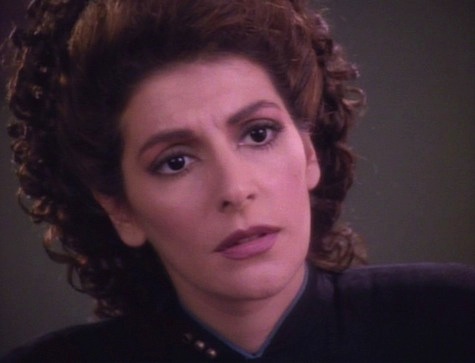
Starfleet dispatches Admiral Nechayev takes command of Starfleet operations in the sector. The U.S.S. Gorkon will be her flagship, with the Crazy Horse and the Agamemmnon being under Picard’s command as Task Force 3.
Nechayev then rips Picard a new one for the events of “I, Borg.” Picard defends himself on the grounds of upholding the Federation’s principles; Nechayev counters with concern for the Federation’s security.
The entire sector is antsy. The Enterprise patrols are interrupted three times by false alarms. Picard is snappish and irritable, going back over the security footage of Hugh’s time on the ship. He admits to Riker that, what he did may have been the moral thing to do, it may not have been the right thing.
La Forge finds Data on the holodeck trying to re-create the events on Ohniaka III, including speaking the same words he used then. He then asks La Forge to disengage the safety protocols, because he knows his life isn’t really in danger—if it is, perhaps the anger will be triggered.
Their argument on the subject is interrupted by red alert—an actual Borg ship this time. The Enterprise gives chase, and gets closer, but it goes into that weird subspace energy field before the Enterprise can fire—however, the ship does get caught in its wake, going through what feels like a wormhole before emerging back in normal space. Data doesn’t have time to determine where they are because the Borg ship’s coming around. They beam two Borg on board, who kill Franklin, another security guard, before Worf takes them both out, but the Borg use the distraction to go into another subspace thingie. However, one of the two Borg is still alive, and neither Borg has disintegrated.
They take the Borg to the brig, where Crusher examines and stabilizes him. The Borg identifies himself as Crosus. He says the name was given to him by the One—“the One who will destroy you.” He doesn’t give any other information, though. Picard sends Crusher to do an autopsy on the other one and asks Data to examine Crosus.
Once he’s left alone with Crosus (well, not alone, there’s a Bajoran security guard just sitting there, but he apparently doesn’t notice what’s happening), the Borg tells Data that he, and he alone, can be assimilated. He activates a chip on his arm, and Data starts to feel again, as Crosus pushes him on the subject of how good it felt to kill, and how he’d do anything to feel that way again.
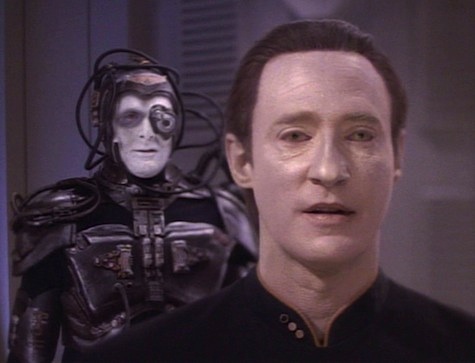
La Forge has determined that the Borg have transwarp conduits throughout space that are triggered by tachyon emissions. And then Data steals a shuttle, with Crosus in tow, and, having disabled the Enterprise tractor beams, activates one of the conduits. La Forge got a good enough reading to duplicate the tachyon pulse, which, eventually, works. They find the shuttle, and also find a couple of worlds with no life signs, but evidence of a civilization, as well as tons of plasma fire.
The shuttle is on a planet that they can’t scan due to high EM energy in the magnetosphere. Riker, Worf, and four security guards beam to where the shuttle is; it’s been abandoned for about three hours. Tricorders are useless, so they need to scan by eye, and they could be up to fifteen kilometers in any direction.
So they have to beam down several four-person search teams doing low-level searching via shuttle as well as on foot. A skeleton crew is left on board, with Crusher in charge, and strict orders to get the hell outta Dodge if the Borg show up regardless of who might still be on the planet.
One of the on-foot teams includes Picard, La Forge, Troi, and a security guard. They find a structure and then inexplicably don’t contact any of the other teams. La Forge finds a door and they go inside. La Forge’s tricorder can’t even read an energy source from the lights in the room, which means there’s a dampening field. Hundreds of Borg come pouring into the room. When the security guard raises his phaser rifle he is, of course, killed (this one didn’t even get a name), and then Lore steps into the room. He’s obviously the One that Crosus was referring to, and he’s got Data on his side now. Data announces that “the sons of Soong” are teaming up to destroy the Federation. Cue diabolical laughter and fade to black.
To be continued…
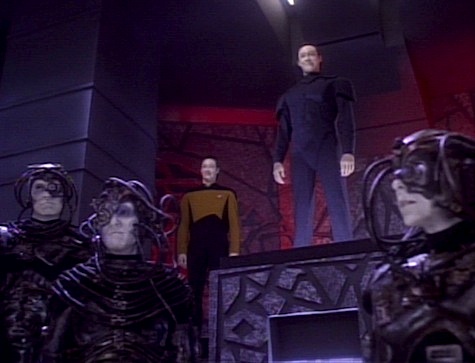
Can’t We Just Reverse the Polarity?: We are introduced to the mighty mighty Borg transwarp conduits, which will continue to play a role on Voyager when they reach Borg space and, indeed, be what gets them home in “Endgame.” The planet Lore has chosen to headquarter on has remarkably plot-convenient EM disturbances.
Thank You, Counselor Obvious: Troi points out to Data (rightly) that there’s no such thing as a negative emotion, but that what makes a feeling positive or negative is what one does with the emotion. She is also the first to realize that Lore is Lore rather than Data in an all-black suit.
If I Only Had a Brain…: Data tells La Forge that he’s felt his first emotion, apparently forgetting the “wonderful feeling” he had when Q gave him the gift of laughter in “Déjà Q.”
What Happens on the Holodeck Stays on the Holodeck: Data uses the holodeck to create the universe’s most awesome poker game, and then uses it to re-create the Ohniaka III base.
I Believe I Said That: “Transmit another copy of Starfleet’s ship-recognition protocols, and tell them to read it this time!”
Picard’s angry order to Worf after the third false alarm in one day.
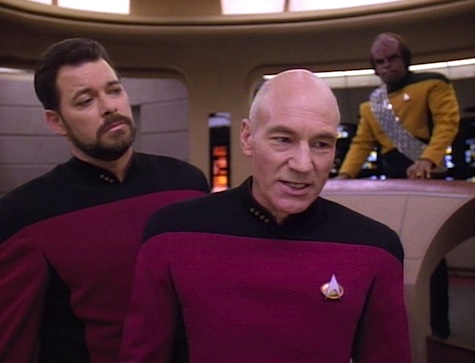
Welcome Aboard: Several excellent guests in this one, most of them in the teaser: the great John Neville as a very tetchy Sir Isaac Newton; Jim Norton making his second appearance as a holographic Albert Einstein, having done so previously to consult with the brain-enhanced Barclay in “The Nth Degree”; and Professor Stephen Hawking appearing as himself. In addition, Natalia Nogulich is back as Admiral Nechayev, last seen in “Chain of Command, Part I,” Brian J. Cousins returns as Crosus, having played the phased Romulan in “The Next Phase,” and at the very end Brent Spiner makes his third appearance as Lore, following “Datalore” and “Brothers.”
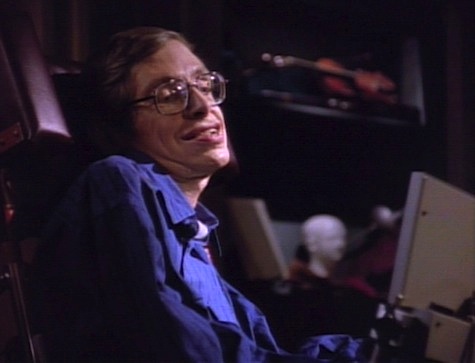
Trivial Matters: The teaser is full of in-jokes, starting with Hawking’s opening bit involving the perihelion precession of the planet Mercury—which Sir Isaac doesn’t get because that perihelion precession can’t be explained via Newtonian physics, but was explained by Einstein’s theory of relativity. Sir Isaac waxes rhapsodic about the apple falling on his head, which Data had believed to be apocryphal, which annoys Sir Isaac no end. (It will be revealed in the Voyager episode “Death Wish” that Q shook the tree that made the apple fall.) Sir Isaac also grumbles about Einstein’s inability to do simple arithmetic, a play on the urban legend that Einstein failed mathematics as a boy. Finally, when Hawking shows his winning hand after Einstein taunts him, he says, “Wrong again, Albert,” a reference to the number of Einstein’s theories that Hawking himself disproved.
This was the first time Hawking appeared as himself on a work of drama, but far from the last—most recently, he’s appeared on two episodes of The Big Bang Theory (a show on which Wil Wheaton also has a recurring role as himself, and on which LeVar Burton once appeared as himself as well).
While being given a tour of the set, Hawking pointed at the warp core and said, “I’m working on that.” William Shatner would later use that quote as the title for his and Chip Walter’s book on how Star Trek has influenced real-world scientists.
This episode serves as a sequel of sorts to “I, Borg,” as the rogue Borg are believed to be the byproduct of Hugh’s “invasive program” of individuality from that episode. And in the end, we find out it’s also a sequel to “Brothers,” as Lore’s presence makes it clear that Data’s emotional outbursts are related to the emotion chip that Lore stole at the end of that episode.
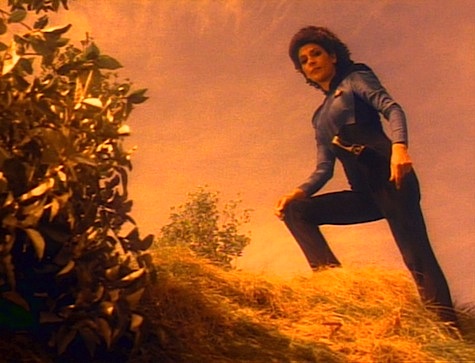
The hill that Picard, Troi, La Forge, and the poor, poor unnamed security guard climb before finding Lore’s stronghold is the same hill on which Spock and Leila’s discussion of rainbows and dragons was filmed for the original series’ “This Side of Paradise.” The exterior of Lore’s stronghold was the Brandeis-Bardin Institutue, the same location used for Camp Khitomer in Star Trek VI: The Undiscovered Country (and was also used in the first five seasons of Power Rangers).
Speaking of Star Trek VI, Nechayev’s flagship is named after the Klingon chancellor from that film, Gorkon (whom your humble rewatcher would use for a Klingon ship name in his Klingon novels), and another starship is named the Crazy Horse, after the person from whom scriptwriter Ron Moore took the “it is a good day to die” Klingon catchphrase.
This and Part 2 were novelized by Diane Carey in a single volume that was released at the same time that Part 2 aired.
Make it So: “All the quantum fluctuations in the universe will not change the cards in your hand.” This really should’ve been a much stronger episode. Much like “Redemption” two years earlier, this has all the right elements: a major issue for one of the main characters, a sequel to an excellent episode that picks up nicely on its themes, and lots of strong action sequences. Plus it has a character reveal at the end—and this one is far stronger than the all-but-irrelevant revelation of Sela.
Yet, just like “Redemption,” “Descent” just feels flat. Everything feels like it’s going through the motions, without any real surprises or tension. The Enterprise doesn’t figure out the transwarp conduits until they need to for the plot, the planet has technobabble nonsense on it that forces an on-the-ground search with tons of people for the express purpose of padding out an episode that didn’t have enough plot and putting Crusher in charge for Part 2. Worse, what could be a wonderful exploration of Data’s evolution—the next step following the dream program activation in “Birthright, Part I”—is instead mind-control by Crosus. And suddenly, everybody gets their very own redshirt, so someone can get killed each time the Borg is engaged—Corelki, Franklin, and another poor bastard who didn’t get named. It’s artificial suspense since we’re given no reason to care about these extras seeing as how the characters themselves don’t seem to give a crap. (One expects better from the guy who wrote “The Bonding.”) To make matters worse, the guard in the brig doesn’t even seem to notice that Data’s being seduced to the Dark Side….
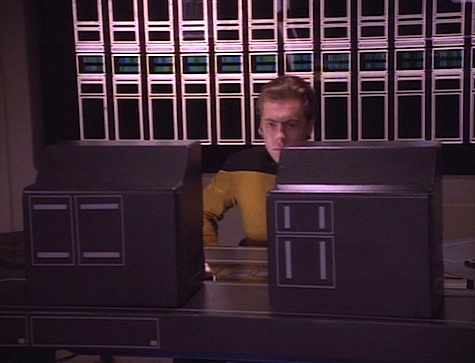
There are moments. The phightin’ physicists poker game in the teaser is a classic (luckily, YouTube allows you to watch the scene without enduring any of the rest of it). Troi’s talk with Data about positive and negative emotions is an excellent one, with really incisive psychological resonances.
But the bit that got me here was Nechayev’s chewing out of Picard. The two of them engage in a debate that will sound very familiar to those of us who’ve lived through the first decade of the 21st century in the U.S.—where do you draw the line between your principles and your need to be secure? At first it seems that the double-fake of Lore being the one in charge of the rogue Borg rather than Hugh seems to cut that notion off at the knees, but as we’ll see in Part 2, it’s a touch more complicated than that….
Warp factor rating: 4
Keith R.A. DeCandido wishes everyone the happiest of holidays.










